G scale 4-foot bridge with round top sides flat black Dubble 0 scale
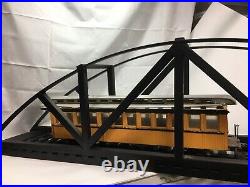
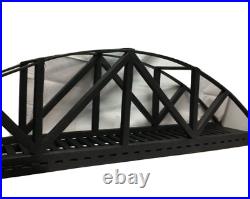
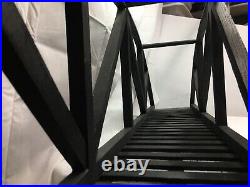
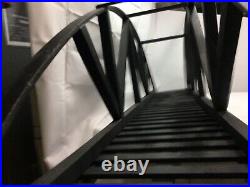
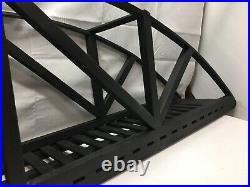
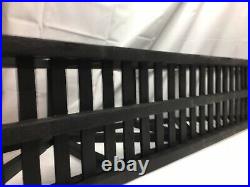
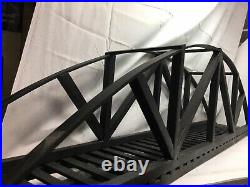
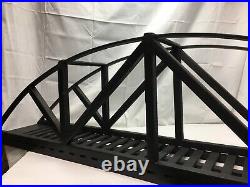
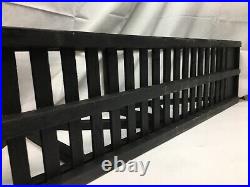
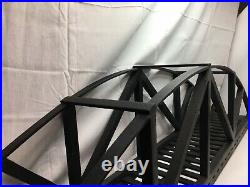
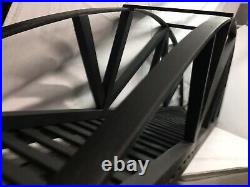
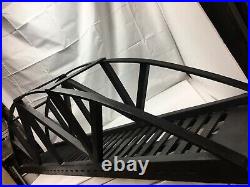

G SCALE 4-foot bridge with ARCH TOP TRUSSELL flat black handmade one of a kind 1/24 DIORAMA MODEL TRAIN BRIDGE NEW Condition is New. 49 inches long 9 inches high. 6 1/2 inches wide on inside of the track and 8 inches wide outside to outside OTHER ITEMS IN PICTURES NOT INCLUDED---------------- BRIDGE ONLY ------- === SCALE 1/24 SCALE wood PAINTED FLAT BLACK and sealed ready to go IN YOUR LAYOUT INSIDE OR OUTSIDE. HERE IS SOME INFO ON TRAIN GARDENS. G scale (or G gauge) is a scale for model railways which, because of its size and durability, is often used outdoors. Such installations are known as garden railways. G scale was introduced by Ernst Paul Lehmann Patentwerk under the brand name LGB and was intended for indoor and outdoor use. Lehman Patentwerk, founded in 1881, started producing LGB in 1968. The remains of the company were bought by Märklin and production of certain items continues. The G name comes from the German word groß meaning "big". More recently some people have come to interpret it as standing for garden scale. G Scale' versus'G Gauge'[edit]. Main article: Rail transport modelling scales.
A railroad gauge is the distance between the railheads. The most common full scale practice has rails spaced 4 ft 8 1/2 in (1,435 mm) standard gauge apart whereas some narrow-gauge railways serving mines, etc. Have rails only 3 ft (914 mm) apart. Although often built with standard-sized doors, a narrow-gauge train is in most other respects smaller than its standard-gauge cousin: its cars are generally narrower and shorter, allowing them to navigate often more sharply curved and lighter built tracks. Model trains are built to represent a real train of standard or narrow gauge.
In an HO model, for example, 16.5 mm gauge track represents standard gauge and a narrower-gauge track such as 9 mm N gauge is used to represent real narrow gauge. G model-railways depart from this and always use the same gauge with the trains instead built in different sizes depending on whether they are intended to represent standard-gauge or narrow-gauge trains. Because of this it might be more correct to speak of "G Gauge, " the consistent aspect being the gauge, 45 mm (1.772 in), and not the scale.The 45 mm gauge originated from'1 gauge' or'Gauge One' which was first used in Europe and England and used to model standard gauge trains in the scale of 1:32. LGB were first to adopt the term'G Scale' and used the gauge of 45 mm (1.772 in) to model 1,000mm gauge European trains in 1:22.5 scale. Below are some typical scales with more specific terms that all run on 45 mm gauge track. Gauge One' scaled at 1:32 (3/8 to the foot) used to model standard gauge trains of 4 ft 8 1/2 in (1,435 mm) standard gauge gauge.
Uncommon term for 1:29 scale first used by AristCraft for modeling standard gauge prototypes on 45mm track. Incorrect scale/gauge but proportionally a similar size to other popular brands of the time.G' scale 1:22.5 used to model European trains that run on 1,000 mm (3 ft 3 3/8 in) metre gauge track. This scale-gauge combination is called'Scale IIm' according to NEM 010. G' term comes from the German word groß meaning "big". H' scale (Half inch) 1/2 to the foot scale. 1:24 used to model 3 ft 6 in (1,067 mm) gauge or'Cape gauge.
Incorrect scale used for 3 ft (914 mm) gauge track. F' scale (Fifteen) 15mm to the foot scale.
1:20.32 Correct scale/gauge typically used to model North American narrow gauge trains on 3 ft (914 mm) gauge track. Seven Eighths' 7/8 to the foot scale. 1:13.7 used to model trains on 2 ft (610 mm) narrow gauge track. 16mm scale' 16mm to the foot scale. 1:19.05 Originally intended for modelling 2 ft gauge prototype railways on 32mm track (SM32).The models are often re-gaugable to also run on 45mm track. This scale has also been used to model 2 ft 6 in (762 mm) gauge prototype trains. A garden railroad or garden railway is a model railway. System set up outdoors in a garden. Is the most popular scale for garden railroads, 16 mm scale.
Has a dedicated and growing following especially in the UK. Model locomotives in this scale are often live steam. Scale models of British narrow gauge. 16 mm scale which runs on.
Track, the same gauge as O gauge is probably now more popular in the UK than G scale. A garden railway's scale tends to be in the range of 1/32 Gauge 1. To 1/12 (1:12), running on either. 1/32 scale (1:32) is also called "three-eighths scale" meaning 3/8 of an inch on the model represents one foot on the real thing.
For similar reasons, 1/24 scale (1:24) is also called "half-inch scale". Other popular scales are 1:29, 1:20.3 representing. Track, 16 mm (1:19). They are smaller than the Backyard railroad.
Or what is commonly called a miniature railway, and would not provide a ride-on facility, being intended instead as a display railway. Smaller scales and gauges are used in the garden, but in general garden railway is used to refer to the medium scale sizes which would be impractical to use indoors. Common switches and accessories control methods. At its most basic level, a garden railway works just like an indoor railway, including turnouts. However, special considerations must be taken for everything from sunlight. The distance covered also means that electrical resistance. In and between sections is much higher, and electrical power. Will tend to drop off at the far end. To eliminate this power issue, some are rigged to use RC car. Parts such as rechargeable batteries. Others even use live steam. And run as a real steam locomotive. The steam can be generated from a variety of sources, ranging from messy solid.Gas, to prototypical coal burners. Live steam is particularly widespread amongst 16 mm scale. Many trains also have digital audio. On board, so they sound like a real train. They can also use Digital Command Control.
Or other similar systems, though dirty outdoor track can cause less of a problem with signal. This is because DCC puts the full voltage on the rails at all times.
There are many benefits of DCC when compared to DC analog systems. Are usually an integral part of a garden railway, and dwarf. Are often used to keep them in proper proportion. Some go so far as to use bonsai.
Techniques, though this can be very time-consuming for large areas. Are also often used in a garden railway, though they too must be constructed to withstand the weather. Are popular, some even building whole towns trackside. The loco shed is a common place to store a locomotive (or the whole train) when not in use. Features are used, such as a small pond.
Tunnels can be a particular challenge. And more like to hide in them, particularly to get out of the rain. Inside a tunnel can also be permanent if careful planning is not done to ensure that it can be reached by access panels trapdoors. Or at arm's length from either end.
A frequent theme is the railway in an idealised urban or rural environment, so it is often found in the context of a model village. Some garden railways work opposite to the model village style and opt more for a railway in the garden, where the railways runs amongst normal plants, not in scale with the railway. These sort of railway designs allow for large scale planting and many gardeners have the railway as a secondary hobby to gardening. Numerous garden rail societies have been formed around the world. Members often invite others over for social gatherings, as well as rotating club meetings. A large setup was on public display at the Atlanta Botanical Garden. During the summer and early fall of 2005, including replicas. In Milwaukee, Wisconsin, the Mitchell Park Horticultural Conservatory.Features an extensive Garden Railway display put on with the cooperation of many Wisconsin Model Railroad club members. The "Domes" as they are known locally, schedules the indoor Garden Railway Show during the cold winter months. It has become one of the most popular displays each year and one of the largest temporary Garden Railway displays in the Midwest. A notable example in England is Bekonscot. Which is the oldest model village.
In the world and has an extensive railway running through a mythical 1930s England. This is well known to be one of the largest, and oldest, garden railways in the UK open to the public. Many owners name their railways, similar to real railroad lines; some with natural-sounding sames, others with playful or fanciful names.
Main articles: Rail transport modelling scales. And Rail transport modelling standards. For historical reasons, the situation is complex. Track, this corresponds to a scale of 1:32.
This gauge, but not the scale, is derived from the standard gauge'Gauge 1' in UK (originally using a scale of 10mm to 1 foot). , if used to represent a. Track, a commonly used Narrow Gauge in many countries i. Australia, Africa, corresponds to a scale of 1:24.
Track, corresponds to a scale of 1:22.5 (IIm). Track, corresponds to a scale of 1:20.3. Track, corresponds to a scale of 1:13.5 SE scale. Near 1:12 or 1 inch to the foot. This larger scale is increasing in popularity., if used to represent a track of. , or just under, corresponds to a scale of 1:19. Sometimes, the 1:19 rolling stock, and particularly live steam locomotives, is equipped for a track of.
This scale is also called 16 mm. In UK, where it is mainly found, because it represents 16 mm for 1 ft. Track, corresponds to a scale of 1:13.5, and this larger scale is increasing in popularity. Track, corresponds to a scale of 1:12.
This combination is not common but has a small number of dedicated followers. At the time (1988), 45mm track was the most common track worldwide. The choice of 1:29 was an attempt to create cars and engines that would compare favorably in size with existing LGB rolling stock which dominated the hobby, and to increase the "wow" factor by making the trains 30% larger by volume than standard 1:32 scale trains.
In addition 1:29 is exactly three times the size of HO scale making it easier to enlarge existing scale model drawings for consumer construction of accessories and scratch-built engines and rolling stock. Since this original venture, at least two other major companies have joined in the 1:29th market (USA Trains and AML/American Mainline) as well as some other smaller companies creating a wide range of rolling stock and locomotives.
Early releases in this scale were more toy like, complete with brass railings and other decorations. Since that time there has been a steady move toward more and more realism with recent releases in live steam radio controlled engines. 1:29 is predominantly American mainline although some locomotives and rolling stock are made for the European market. If one will represent a modern epoch, there is need for road cars and trucks which are only offered in 1:18, 1:24 and 1:32 scale. Modellers are making compromises and 1:22.5 trains are commonly associated with 1:24 accessories figures, animals, cars, etc. There is a conflict on the designation of'G' scale (created by LGB), the NMRA.Was initially willing to use it only for scale 1:22.5 but manufacturers hoping to benefit from the notoriety of the'G' naming continue using this reference for scales 1:20.3, 1:24, 1:29, and 1:32. All these scales would more correctly fall under the name of G gauge, referencing the width of the track, rather than G scale, as there are so many scales now claiming to be G. A recent move has been made to separate all the G gauge scales, the primary one being the use of F scale for 1:20.3.
In short: (width while on scale -> width effectively used). This item is in the category "Toys & Hobbies\Model Railroads & Trains\Railroads & Trains\Locomotives". The seller is "goldensalesman" and is located in this country: US.
This item can be shipped to United States, Canada, United Kingdom, Denmark, Romania, Slovakia, Bulgaria, Czech Republic, Finland, Hungary, Latvia, Lithuania, Malta, Estonia, Australia, Greece, Portugal, Cyprus, Slovenia, Japan, China, Sweden, Korea, South, Indonesia, Taiwan, South Africa, Thailand, Belgium, France, Hong Kong, Ireland, Netherlands, Poland, Spain, Italy, Germany, Austria, Bahamas, Israel, Mexico, New Zealand, Philippines, Singapore, Switzerland, Norway, Saudi Arabia, United Arab Emirates, Qatar, Kuwait, Bahrain, Croatia, Republic of, Malaysia, Brazil, Chile, Colombia, Costa Rica, Panama, Trinidad and Tobago, Guatemala, Honduras, Jamaica, Antigua and Barbuda, Aruba, Belize, Dominica, Grenada, Saint Kitts-Nevis, Saint Lucia, Montserrat, Turks and Caicos Islands, Barbados, Bangladesh, Bermuda, Brunei Darussalam, Bolivia, Ecuador, Egypt, French Guiana, Guernsey, Gibraltar, Guadeloupe, Iceland, Jersey, Jordan, Cambodia, Cayman Islands, Liechtenstein, Sri Lanka, Luxembourg, Monaco, Macau, Martinique, Maldives, Nicaragua, Oman, Peru, Pakistan, Paraguay, Reunion, Vietnam, Uruguay.
- Brand: LGB
- Power Type: AC
- Type: Locomotive
- Rail System: 3-Rail-3-Conductor
- Corporate Roadname: Amtrak
- Color: Beige
- Replica of: Acela Express
- Wheel Configuration: 2-8-2
- Material: Wood
- Features: Advertising Specimen
- Control System: Digital
- Gauge: G
